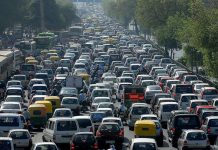In Reopening Its Economy, Iran’s Regime Relies on Disinformation, Disregard for Human Life

Written by
Mahmoud Hakamian
In Reopening its Economy, Iran’s regime Relies on Disinformation, Disregard for Human Life
Iran: Heavy traffic in Tehran due to re-opening business activities despite still being amid the worst coronavirus outbreak in the Middle East
Iranian regime is currently in the process of re-opening business activities despite still being amid the worst coronavirus outbreak in the Middle East.
Questions about the official infection rates and death tolls leave open the possibility that Iran’s outbreak is among the worst in the world. And this in turn underscores the extent to which the Iranian regime places self-serving economic priorities and its own power ahead of human life.
Officially, just over 6,000 Iranians have died of Covid-19 since the presence of the illness was confirmed on February 19. The same official estimates indicate that Iran has just surpassed 100,000 total cases. However, the Health Ministry is reportedly not using antibody tests and is even attempting to ship its own to Europe. This betrays the regime’s interest in avoiding confirmation of prior coronavirus infections, to downplay the extent of the outbreak.
Nevertheless, one member of the regime’s coronavirus task force stated last month that the illness had likely spread to more than half a million people. Even earlier than that, the National Council of Resistance of Iran (NCRI) suggested that the total number of infections could probably be measured in the millions. The NCRI has also continually revised mortality estimates and now it has announced that Covid-19 has killed around 40,000 people in Iran.
This estimate is derived, in part, from hospital records obtained by an intelligence network affiliated with the People’s Mojahedin Organization of Iran (PMOI-MEK). It also aligns with testimony from Iranian doctors, nurses, morgue attendants, and other eyewitnesses to the outbreak. As well as reporting that many hospitals were overwhelmed with patients and were routinely reporting dozens of deaths per day, these individuals have frequently suffered arrest or harassment by authorities, for the crime of “rumor mongering.”
In what were ostensibly the early stages of the outbreak, the Iranian judiciary made it clear that the penalty for this crime was up to three years in prison, plus flogging. The threat left little doubt that the regime was already committed to suppressing alternative accounts of Covid-19’s impact and the Iranian government’s response to it. Among other “rumors,” the authorities sought to counter public descriptions of an outbreak that was under way long before the regime acknowledged it.
These rumors were confirmed in March when the MEK intelligence network uncovered documents from Iran’s National Emergency Organization, which demonstrated that patients suffering from coronavirus infection had been admitted to Iranian hospitals as early as January. But the regime was already losing its battle against the truth within about a week of its first public statement regarding the outbreak.
At the time, regime’s authorities were still insisting that only about a dozen people had died from Covid-19, but at least one local official spoke out to say that upwards of 50 fatal cases had been recorded in the city of Qom alone. The early disinformation goes a long way toward explaining the dramatic mismatch between official death tolls and those reported by independent sources like the NCRI.
Iran regime’s countermeasures were put into place much later than in neighboring countries, despite the Iranian outbreak having started much earlier. And now that those countermeasures are winding down, Tehran’s account of their impact is becoming less and less plausible, thanks to the volumes of information being smuggled out of the country by Iranian social media users, activists, and most importantly by the Iranian Resistance.
Nevertheless, the restrictions on commerce and travel are now winding down, with about a third of Iran’s administrative divisions already being declared practically clear of the virus. This flies in the face of advice from the regime’s own Health Ministry officials, who insist there are no “white zones” anywhere in the country. Persons outside of the regime hierarchy are naturally sounding even more serious alarms. At least one study has run models starting with the death tolls provided by the NCRI and has determined that the number of fatalities could more than double by the end of May unless the regime changes course. But that is unlikely to happen.
The prospect of even larger-scale sickness and death is not sufficient to make the regime reconsider this strategy, even though it could very easily do so. The regime’s supreme leader and its paramilitary are sitting on hundreds of thousands of dollars in assets, which could be used to help the Iranian people weather this crisis and avoid even worse levels of poverty than they are already experiencing.
But in utilizing these resources, the authorities would be drawing against long-term plans to continue funding regional militant groups, developing, and testing ballistic missiles, and otherwise presenting an image of strength to foreign adversaries. This is more important to the mullahs than human lives. Those selfish priorities are poorly concealed by the disinformation is now using to justify the resumption of economic activity.
Comparatively few Iranians will be taken in by this disinformation. But that does not alter the fact that in absence of meaningful support from the regime, but to pay the price of the regime’s plans. On the other hand, this compliance only extends as far as is needed to stave of personal financial ruin. In the long run, as the extent of Iranian regime’s disregard for human life becomes clearer and clearer, many of those same citizens will surely do what they can to hold the regime to account, in line with countless anti-regime protests that have rocked the nation in recent years.

